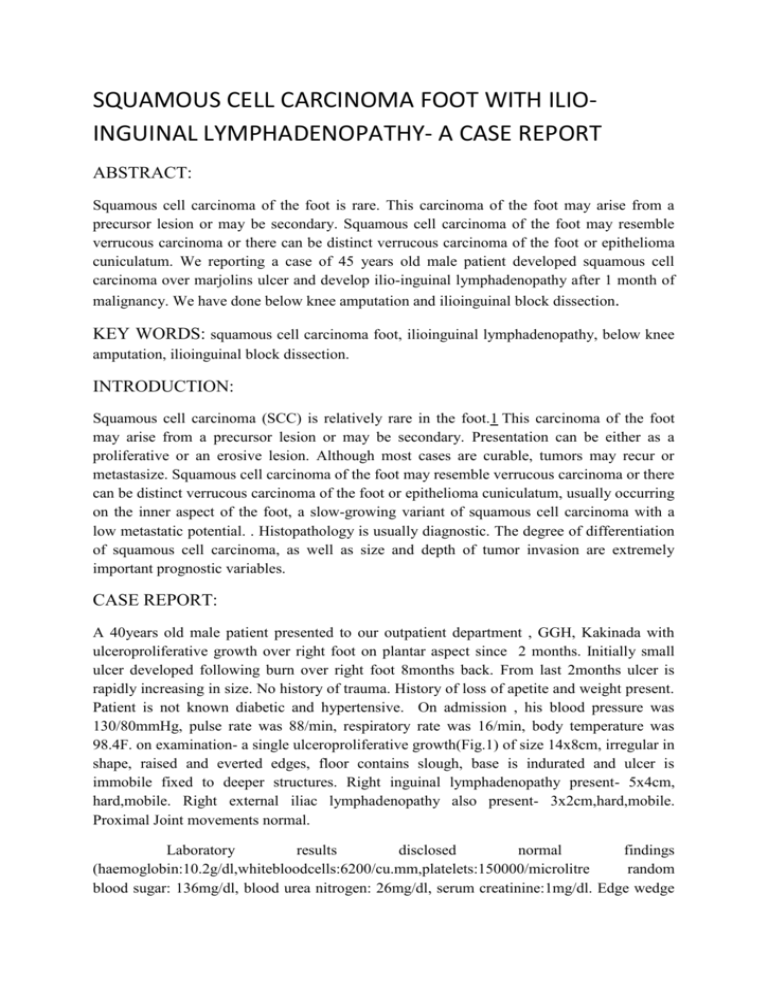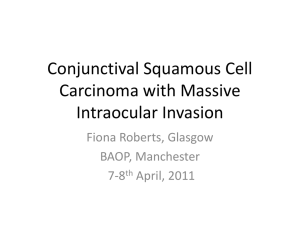squamous cell carcinoma foot with ilio
advertisement

SQUAMOUS CELL CARCINOMA FOOT WITH ILIOINGUINAL LYMPHADENOPATHY- A CASE REPORT ABSTRACT: Squamous cell carcinoma of the foot is rare. This carcinoma of the foot may arise from a precursor lesion or may be secondary. Squamous cell carcinoma of the foot may resemble verrucous carcinoma or there can be distinct verrucous carcinoma of the foot or epithelioma cuniculatum. We reporting a case of 45 years old male patient developed squamous cell carcinoma over marjolins ulcer and develop ilio-inguinal lymphadenopathy after 1 month of malignancy. We have done below knee amputation and ilioinguinal block dissection. KEY WORDS: squamous cell carcinoma foot, ilioinguinal lymphadenopathy, below knee amputation, ilioinguinal block dissection. INTRODUCTION: Squamous cell carcinoma (SCC) is relatively rare in the foot.1 This carcinoma of the foot may arise from a precursor lesion or may be secondary. Presentation can be either as a proliferative or an erosive lesion. Although most cases are curable, tumors may recur or metastasize. Squamous cell carcinoma of the foot may resemble verrucous carcinoma or there can be distinct verrucous carcinoma of the foot or epithelioma cuniculatum, usually occurring on the inner aspect of the foot, a slow-growing variant of squamous cell carcinoma with a low metastatic potential. . Histopathology is usually diagnostic. The degree of differentiation of squamous cell carcinoma, as well as size and depth of tumor invasion are extremely important prognostic variables. CASE REPORT: A 40years old male patient presented to our outpatient department , GGH, Kakinada with ulceroproliferative growth over right foot on plantar aspect since 2 months. Initially small ulcer developed following burn over right foot 8months back. From last 2months ulcer is rapidly increasing in size. No history of trauma. History of loss of apetite and weight present. Patient is not known diabetic and hypertensive. On admission , his blood pressure was 130/80mmHg, pulse rate was 88/min, respiratory rate was 16/min, body temperature was 98.4F. on examination- a single ulceroproliferative growth(Fig.1) of size 14x8cm, irregular in shape, raised and everted edges, floor contains slough, base is indurated and ulcer is immobile fixed to deeper structures. Right inguinal lymphadenopathy present- 5x4cm, hard,mobile. Right external iliac lymphadenopathy also present- 3x2cm,hard,mobile. Proximal Joint movements normal. Laboratory results disclosed normal findings (haemoglobin:10.2g/dl,whitebloodcells:6200/cu.mm,platelets:150000/microlitre random blood sugar: 136mg/dl, blood urea nitrogen: 26mg/dl, serum creatinine:1mg/dl. Edge wedge biopsy from ulcer - moderately differentiated squamous cell carcinoma. FNAC from ilioinguinal lymphnodes- malignant epithelial deposits of squamous cell nature. X-Ray right foot shows osteolytic lesion of calcaneum(Fig.2). CT chest and abdomen- normal. Case posted for right below knee amputation and ilioinguinal block dissection(Fig.3). The post operative outcome was uneventful, and the patient was discharged on 10th day. Post operative biopsy from growth and inguinal lymphnodes revealed squamous cell carcinoma. Fig1. Ucerative growth with ilioinguinal LN Fig2.X-Ray foot–osteolytic lesion of calcaneum Fig 3. Intra operative photograph showing ilio inguinal block dissection DISCUSSION: Approximately 80% of non-melanoma skin cancers are basal cell carcinoma and 20% are squamous cell carcinoma. This squamous cell carcinoma originates from the prickle cell layer of skin and may show varying degrees of differentiation and keratinization. SCC is linked to exposure to ultraviolet light, its most common etiology. The UVL (ultra-violet light) acts as both a tumor promoter and initiator by suppressing the tumor suppressor gene. For this reason, the location of SCC typically involves areas of sun-exposed skin, with only 2.4% occurring on the foot. There exists a strong link between immuno-compromised patients and the development of SCC. Patients receiving immunosuppressive therapy for organ transplant have an occurrence rate 65-250 times more than the general population. A subset of SCC arises from previously injured areas of skin and is referred to as Marjolin’s ulcer, the majority of which are located in the lower extremity. Marjolin’s ulcer is a term used to describe malignancy involving a post-traumatic scar and post burn scar. In the foot, this cancer may arise from lichen planus, deep mycosis, lichen simplex chronicus, plantar verruca or this can be secondary.(2) Metastatic squamous cell carcinoma of the foot is very rare. Clinical appearance of squamous cell carcinoma is variable and the tumor may present as a thin, red or brown nodule with or without scaling, a focus of induration, an ulcerated lesion plaque or an exophytic, cauliflower-like growth. A high index of suspicion is necessary to make the early diagnosis of malignancy and prevent spread of lesions.(3) Among radiological investigations, Magnetic Resonance Imaging (MRI) helps to determine the presence and extent of disease in the skin, surrounding tissue and adjacent bones and therefore aids in surgical planning. Cure rates have been estimated at around 90% for SCC treated with the available modalities. An initial wide excision for squamous cell carcinoma of the foot is the treatment of choice and may prevent metastasis. Inadequate excision associated with recurrence should be treated by amputation.(4) Altay M et al. suggested that the treatment of choice for squamous cell carcinoma of the foot is amputation and routine lymphadenectomy at the time of management is unnecessary, but regional lymphadenopathy persisting three months after amputation warrants surgical intervention.(5) The treatment that offers the highest rate of cure for patients with high-risk primary or recurrent squamous-cell carcinoma is Mohs micrographic surgery. Appropriate use of electrodesiccation and curettage, excision, or cryosurgery can eliminate up to 90% of local tumors with low risk of metastasis, Left external iliac catheterization and intra-arterial infusion with methotrexate with salvage by leucovorin is a simple and effective method for squamous cell carcinoma of the foot with the unique advantage of preservation of organ and function.(1 )The five-year rate of cure in patients with large tumors is 70%, regardless of the treatment chosen. Metastatic potential of squamous cell carcinoma is often underestimated. Sentinel Lymph Node Biopsy (SLNB) accurately diagnoses subclinical lymph node metastasis with few falsenegative results and low morbidity. The majority of the metastatic lesions originate from primary tumors stratified in the "high-risk" category; the characteristics of high-risk squamous cell carcinoma on extremities being size >2.0 cm, indistinct clinical borders, rapid growth, multiple lesions, ulceration, recurrence after previous treatment, with histopathological documentation, poor differentiation, deep extension of the tumor into subcutaneous fat, perineural/perivascular or intravascular invasion. A tumor size larger than 2 cm doubles the recurrence rate and triples the metastatic rate as compared with lesions less than 2 cm. While squamous cell carcinoma developing from precursor lesions such as actinic keratoses are considered less likely to metastasize, secondary squamous cell carcinomas, which have the poorest prognosis, include tumors that develop in burn scars, in sites of radiation damage and in sites of chronic inflammation such as osteomyelitic foci and, at times, chronic leg ulcers. CONCLUSION: Squamous cell carcinoma of foot is rare to see. It can be a primary or metastic lesion. Amputation is treatment of choice as Cancer that has invaded so deep that excision is impossible , Involvement of a large joint, such as the ankle , Large areas of necrotic bone exposed. Local excision would result in a non-functional limb. REFERENCES: 1. spinosa FA. Squamous cell carcinoma of the plantar aspect of the foot. J Foot Surg. 1987; 26:253-255. 2. Shahid Majeed, Bari AU. Squamous cell carcinoma foot arising in deep mycosis. A case report. J Surg Pak 2004; 9:54-55. 3. Sheen YS, Sheen MC, Sheu HM, Yang SF, Wang YW. Squamous cell carcinoma of the big toe successfully treated by intra-arterial infusion with methotrexate. Dermatologic Surgery 2003; 29:982-983. 4. Schroven I, Hulse G, Seligson D. Squamous cell carcinoma of the foot: Two case reports. Clinical orthopaedics and related research 1996; 328:227- 230. 5. Altay M, Arikan M, Yildiz Y, Saglik Y. Squamous cell carcinoma arising chronic osteomyelitis in foot and ankle. Foot Ankle Int. 2004; 25:805-809. 6. Baldursson B, Sigurgeirsson B, Lindelöf B. Leg ulcers and squamous cell carcinoma. An epidemiological study and a review of the literature. Acta Derm Venereol 1993; 73:171-17 AUTHORS 1) DR. V.RAMBABU .MS , ASSOCIATE PROFESSOR, DEPARTMENT OF GENERAL SURGERY,RANGARAYA MEDICAL COLLEGE,KAKINADA-533001 2) DR.K.BABJI .M.S;MCH,PROFESSOR & HOD, DEPARTMENT OF GENERAL SURGERY,RANGARAYA MEDICAL COLLEGE,KAKINADA-533001 3) DR .N.DINESH KUMAR REDDY,PG IN DEPARTMENT OF GENERAL SURGERY,RANGARAYA MEDICAL COLLEGE,KAKINADA-533001 4) DR.SANTHOSH KUMAR, PG IN DEPARTMENT OF GENERAL SURGERY,RANGARAYA MEDICAL COLLEGE,KAKINADA-533001






